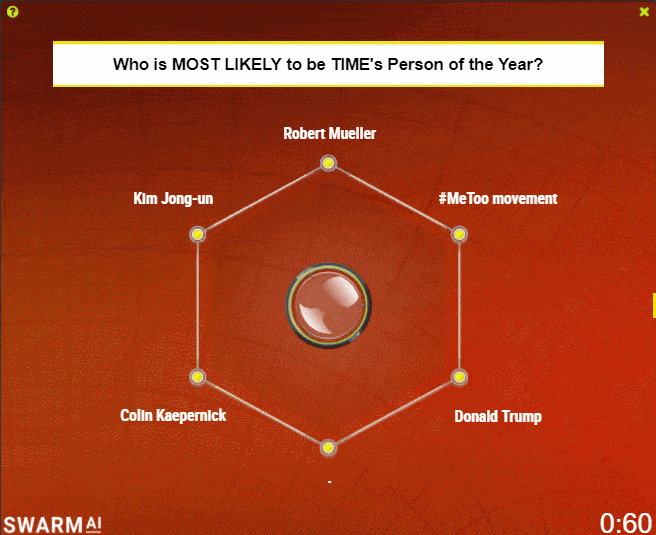By combining artificial intelligence and the wisdom of the crowds in real-time, a swarm intelligence was able to predict TIME’s Person of the Year for 2017. It’s the second time in a row that Unanimous AI’s artificial swarm intelligence, known as UNU, is right — after correctly predicting Donald Trump for 2016.

TIME Magazine’s “Person of the Year” has grown into one of the most anticipated end-of-year releases, and also one of the most coveted awards for the world’s elite. Since 1927, the magazine has awarded the title every year to the person or group of people that have had the most influence on the news and society in the last 12 months. This means that the award doesn’t go the ‘greatest’, ‘smartest’ or ‘kindest’ — just the most influential. Case in point, TIME Magazine handed out the award to all sorts of people, from Mahatma Gandhi to Adolf Hitler to Joseph Stalin (twice).
AI Hive Mind
To predict — and with a staggering accuracy to boot — which person TIME Magazine will bestow its prestigious award to, researchers at Unanimous AI had to think of a system that can sift through a lot of noise and uncertainties. This year, for instance, TIME had published a list of 33 options on their website to choose from. That’s quite a lot. Ultimately, Unanimous’ ingenious solution was to devise a machine that thinks like a swarm — a hive mind.
Swarm intelligence is a decentralized collective behavior that evolved to enabled simple organisms to solve complex problems. Alone, a bee or an ant is quite dumb but together, their respective swarms are capable of phenomenally intelligent behavior. That’s also why birds flock and fish school — it allows them to react in optimal ways by combining the information that they have.
Louis Rosenberg founded Silicon Valley startup Unanimous AI taking cues directly from swarm intelligence found in nature.
“If you look at social species like bees they work together to make better decisions — can people do that?” Rosenberg asked rhetorically.
It turns out that they can.
Just like bees, most individual people aren’t very smart. Together, however, there’s a wisdom to crowds, a collective insight otherwise oblivious to the individual. Scholars have known about it for years. For instance, one textbook example is Francis Galton 1906 experiment in which he asked 787 farmers to guess the weight of an ox. Their individual answers were way off but Galton found their average was correct within a pound of the real measurement of 1,197 pounds.
Rosenberg’s algorithms, however, are a step further than the conventional wisdom of the crowds. While crowds tend to find better answers than individuals via mechanisms like polls or votes, swarms can be more efficient because they converge towards the best answers rather than an average.

When a swarm of bees needs to set up a new colony, first a couple of scouts explore for an optimal location. The scouts then return to the swarm in front of which they perform a wiggle dance, communicating details about the prospective location. The swarm will push and pull towards various scouts until one of them wins, a decision that no individual bee could ever make.
Who’s the fairest of them all?

A similar dynamic is employed by UNU which combines real-time human input with algorithms to produce what Rosenberg calls an “emergent hive mind.”
So far, UNU has had remarkable success at predicting all sorts of events packed with uncertainties. Among them, the winners of the 2015 Oscars, the winners of the 2016 National Hockey League’s Stanley Cup or the four winning horses in order of the 2016 Kentucky Derby — at 542 to one odds. The swarm intelligence algorithms also correctly selected Donald Trump as last year’s TIME Person of the Year, who was awarded a 98% win chance.
Towards the end of November, UNU favored Russian President Vladimir Putin for the cover of TIME but in a December 4 update, the swarm chose a different direction. Its top 5 shortlist didn’t even include Putin anymore.

Instead, UNU chose the #MeToo Campaign as this year’s winner for the TIME Magazin Person of the Year. Two days later, on December 6, TIME confirmed #MeToo won under the name “The Silence Breakers” — a collective of people who have spoken out against sexual harassment.
Predicting the Person of the Year is no easy task, not even for a sophisticated machine like UNU. But even so, it’s been right on spot for the second year in a row.
“Forecasting using Swarm AI technology is all about generating optimized outcome probabilities for the various alternatives by weighting competing sets of information and converging on solutions that maximize the collective confidence inherent in a population,” Rosenberg told Futurism. “This means, as world events changed in real-time over the last few weeks, the swarming algorithms allowed the forecasts to adapt, converging on updated probabilities.”
There’s more to UNU than just winning bets. First and foremost, UNU is a decision-making tool that could have an important impact in many fields. One of the first things that come to mind is medical diagnosis which could be dramatically improved by swarm intelligence. Beyond medicine or IT, UNU and other swarm intelligence like it, might become humanity’s great sidekick in the future. By combining the swarm’s cold and calculated thinking with humans’ warm intuition, our species might become unstoppable.


